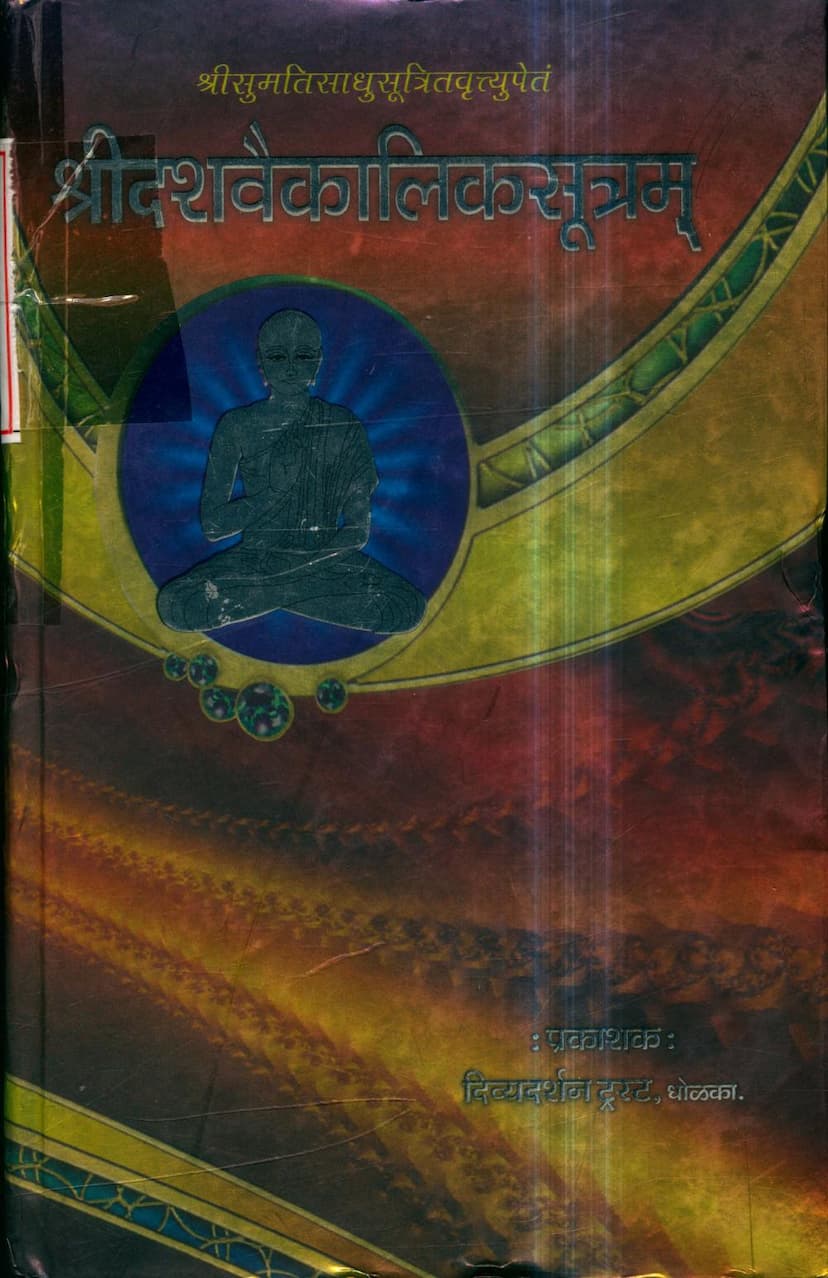Dashvaikalaik Sutram
Added to library: September 1, 2025

Summary
The Dashavaikalika Sutra, as presented in this edition, is a foundational Jain scripture composed by Shrutakevali Shrimad Shyyambhava Suri and meticulously commented upon by Acharya Shrimad Sumatisadhusuri. The work has been compiled and edited by the esteemed Acharya Bhagavant Shrimad Vijay Abhaychandra Suriji Maharaja, published by Divyadarshan Trust, Dholka.
The text is presented with deep reverence, acknowledging the lineage of great gurus including Vārdhamāna, Shrimad Vijay Premsurishwarji Maharaja, Shrimad Vijay Bhuvanbhanusurishwarji Maharaja, Pandit Shri Padmavijayji Ganivarya, Shrimad Vijay Jayghoshsurishwarji Maharaja, and Shrimad Vijay Jagachandrasurishwarji Maharaja. The publication is also dedicated to the 25th anniversary of the Acharya Pad of Shrimad Vijay Jagachandrasurishwarji Maharaja.
The Significance of Dashavaikalika Sutra:
The text emphasizes the profound importance and multifaceted significance of the Dashavaikalika Sutra in Jainism, describing it as:
- An extraordinary compilation by a father for his ascetic son to guide him in the afterlife.
- One of the fundamental 'Moola Sutras' among the 45 Agamas.
- The "ABCD" for entering the life of an ascetic (Shramana).
- A scripture studied immediately after the Aupadesika Sutra upon initiation.
- A prerequisite for higher initiation, as the first four chapters must be mastered.
- A text that has been exceptionally popular among ascetics since its creation.
- One of the few scriptures destined to endure until the end of the fifth era.
- A magnum opus with extensive commentaries, explanations, and translations, indicating its depth and value.
- Its verses are recited in auspicious rituals and occasions.
- A Sutra whose 17 verses are essential, with ascetics not taking food or water without reciting them.
- An Agama whose four chapters were recited by Acharya Vijay Sen Suri before undertaking vows, highlighting its foundational role.
- A scripture that incorporates two 'Chulikas' (appendices) from the four Chulikas received from Lord Simandhar Swami.
- A scripture containing numerous other diverse and hidden excellences.
The editor, Acharya Shrimad Vijay Abhaychandra Suriji Maharaja, expresses his personal affection for the Sutra, having memorized it completely after initiation and finding immense value in its eighth chapter, "Acharapraṇidhi," which he frequently quotes in discourses. He encourages monks to prioritize memorizing the eighth chapter even if they cannot complete the entire text, as it is believed to purify the soul's disposition.
The Structure and Content:
The Dashavaikalika Sutra consists of:
- 10 Adhyayanas (chapters)
- 2 Chulikas (appendices)
- 6 Uddeshas (sections within chapters)
- 21 Sutras (aphorisms)
- 515 Gathas (verses)
- 1 Praksipta Gatha (interpolated verse)
- 222 Pages
The book provides a detailed index of the Sutra's content, outlining the subject matter of each chapter and section, covering topics such as:
- Chapter 1: Drum Pushpika: Discusses the nature of dharma, the path of an ascetic, comparing them to bees gathering nectar without harming flowers. It emphasizes detachment from worldly pleasures and the importance of righteous conduct.
- Chapter 2: Shramanyapurvika: Focuses on the essence of asceticism, the importance of controlling desires and thoughts, and the distinction between a true renunciate and one who merely adopts the outward appearance. It highlights the need for detachment and self-control.
- Chapter 3: Kshullakachara Katha: Details the conduct of a novice ascetic (Kshullaka), emphasizing adherence to rules and avoiding actions that harm living beings. It lists numerous prohibited actions related to the body, food, and possessions.
- Chapter 4: Shad Jivanikayika: A crucial chapter that expounds on the six classes of living beings (earth-bodied, water-bodied, fire-bodied, air-bodied, plant-bodied, and mobile beings) and the imperative of non-violence towards all of them. It elaborates on the intricacies of ahimsa and the ethical conduct required of ascetics concerning these beings.
- Chapter 5: Pindeshana: Deals with the principles of obtaining alms (Pindeshana), emphasizing ethical collection of food, avoiding impure or prohibited items, and maintaining a detached attitude towards sustenance.
- Chapter 6: Mahachara Katha: Discusses the great conduct and virtues expected of ascetics, including self-control, patience, renunciation, and adherence to the vows.
- Chapter 7: Vakyashuddhi: Focuses on the purity of speech, highlighting the importance of truthful, non-harmful, and beneficial communication, while avoiding gossip, harsh words, and falsehoods.
- Chapter 8: Acharapranidhi: Emphasizes the importance of meticulous conduct and mindfulness in all actions, ensuring that every step taken and every action performed is in accordance with dharma and causes no harm.
- Chapter 9: Vinayasamadhi: Stresses the significance of humility, respect, and discipline towards gurus, fellow ascetics, and all beings. It outlines the various aspects of true humility and its role in spiritual progress.
- Chapter 10: Sabhikshu: Defines the ideal characteristics and conduct of a perfect monk (Bhikshu), highlighting self-control, detachment, purity of conduct, and the pursuit of liberation.
The Chulikas:
The two Chulikas further elaborate on crucial aspects of ascetic practice:
- First Chulika: Rativaryaka: Likely deals with the avoidance of attachment and aversion, particularly concerning sensory pleasures and emotional states that can hinder spiritual progress.
- Second Chulika: Viviktacharya: Focuses on the practice of solitary and secluded conduct, emphasizing the importance of maintaining a pure and undisturbed inner state, essential for deep meditation and spiritual realization.
This edition is a valuable resource for understanding the profound teachings and practical guidelines for ascetics within the Jain tradition, particularly the emphasis on ahimsa, self-control, and devotion to the teachings of the Tirthankaras.